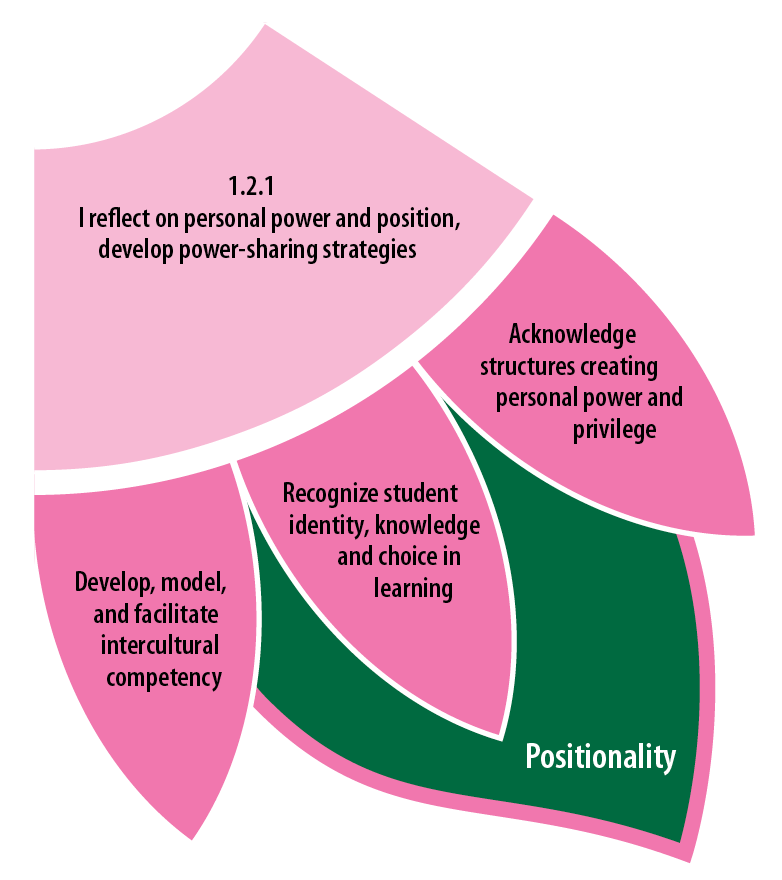Positionality in the Classroom: An EDI Principle
Considering our personal position and power in the classroom and its impacts on our relationships with students is the first step in implementing EDI into our teaching.
By Gwenna Moss Centre for Teaching and LearningThis article is part of a series about integrating EDI principles into our teaching and learning design and practices.
Understanding one's positionality as an educator can significantly contribute to creating an inclusive classroom environment.
In A Teaching Tool: The EDI Flower, six EDI principles as illustrated in the EDI Flower were defined. The first principle, Positionality, encourages reflection on our role and its impact on classroom dynamics, power structures, and intercultural competence.
| Positionality refers to one's location in relation to their various social identities, such as gender, race, class, ethnicity, ability, and geographical location. The interplay of these identities and their intersections shapes our understanding of and engagement with the world, influencing our knowledge, perspectives, and teaching practices. As individuals and instructors, we hold multiple identities that are fluid, contextually situated, and continuously evolving (Alcoff, 1988). |
Click on the image to open larger version
The pink flower petals suggest three possible overarching strategies we can develop when aware of our positionality.
Creating an awareness of one’s personal power and position is essential to further development.
Awareness of Positionality
Awareness of one's positionality involves recognizing and reflecting on the various social identities and experiences that shape who we are and how we interact with the world.
It starts with reflection on our various identities and their influence on our perspectives, behaviors and interactions, helping us realize our biases and privileges.
Positionality also involves comprehending the social and historical contexts that shape our experiences and those of others, highlighting power dynamics and systemic inequalities.
It is an ongoing process of continuous learning about self and others and being open to new perspectives and experiences.
Why it matters
Recognizing our social identities, privileges, and biases allows us to be mindful of how these factors influence our teaching and interactions with students. Our positionality influences all aspects of
- what content we choose,
- the activities and practices we use,
- and the way we assess.
Awareness can:
- Help us address unconscious biases and strive for equity in the classroom.
- Nurture our empathy to help foster a supportive and respectful classroom atmosphere.
- Guide curriculum design that is inclusive and representative of diverse perspectives. This can help ensure that all students feel seen and valued in the course content.
- Set a positive example for our students, encouraging them to reflect on their identities and how these impact their interactions and learning.
Resources to explore positionality
- Positionality and Intersectionality (Chapter in Open Library)
- Exploring My Identity, Positionality, Biases and Perspectives (Canvas Module) – Contact Roberta at campbell@usask.ca to access this non-monitored module
Conclusion
The ongoing journey of self-awareness and reflection not only enhances our teaching practices but also sets a powerful example for our students. As we continue to grow, we can address unconscious biases, foster empathy, and design curricula that reflect diverse perspectives. Ultimately, understanding our positionality empowers us to create a more inclusive and supportive learning environments, benefiting our students and us, as educators.
References
-----
This article series is a detailed exploration of the USask EDI Framework Principles and its application in course design and our classrooms.
- Empowering Education: Embracing Equity, Diversity, and Inclusion at USask
- Fostering Inclusive Learning Environments at USask: The EDI Framework for Action
- A Teaching Tool: The EDI Flower
- Positionality in the Classroom: An EDI Principle (current article above)
- Designed to be Equitable: An EDI Principle
- Honouring Indigenous Knowledges in Higher Education
- Crediting Indigenous Knowledge and Sources
Title image credit: Vilius Kukanauskas on Pixabay


